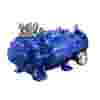Thermal management is essential for the reliable operation of chemical dry screw vacuum pumps.
In a pump that is too cool for a given process, aggressive vapors may condense, leading to corrosion, the dilution of lubricants, and the swelling of seals. This damage is serious but can only happen if the vapor is allowed to condense into the liquid phase.
Conversely, if the operating temperatures in the pump are too high for a given process, unwanted reactions such as polymerization or auto-ignition are possible, with the addition of high bearing temperatures or thermal seizure.
The effects mentioned above can be mitigated slightly by internal coatings but this is something that should never be relied on. Coatings work great to protect the pump during initial storage and system commissioning but they can only survive so long at the temperatures and vacuum levels where the pumps spend most of their time.
The key is to ensure that the process vapors stay in the vapor phase [Green area] in the figure below. A few strategies to ensure this occurs include temperature/flow control of the pump coolant, use of nitrogen purge to change process dew point, and the use of inlet condensers to remove the vapor upstream of the pump.
To further improve reliability where system challenges are always present, additional features can be added to the pump system to help guarantee reliability. One example is a solvent flush system to keep the pumping mechanism free and clean. Another being knock-out pots (KOPs) and filters to capture liquid or powder slugs when unable to prevent them.









